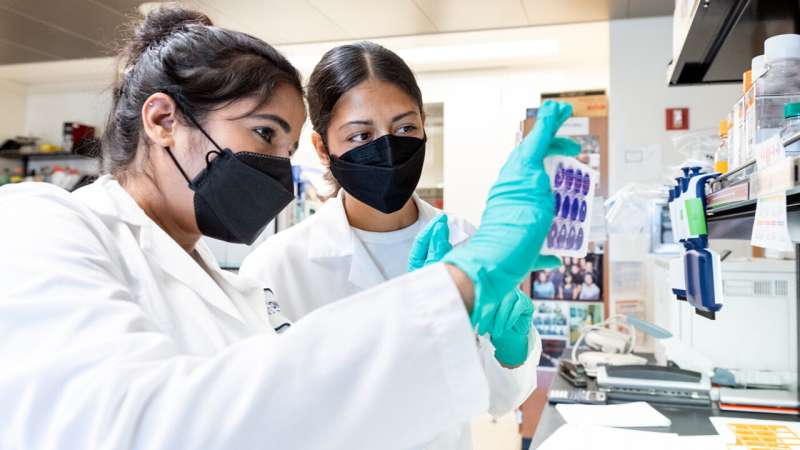
By the time you test positive for COVID-19, the SARS-CoV-2 virus has already taken up residence in your respiratory system. With each breath, you expel invisible viral particles into the air—a process known as viral shedding. Existing drugs aimed at treating COVID-19, even when they address symptoms of the virus, do little to quell viral shedding.
Researchers at Gladstone Institutes previously developed a novel approach for treating infectious diseases: a single-dose, intranasal treatment that protects against severe SARS-CoV-2 infection.
In a new study published in Proceedings of the National Academy of Sciences, they show that this new treatment, called a therapeutic interfering particle (TIP), also decreases the amount of virus shed from infected animals and limits transmission of the virus.
“Historically, it has been exceptionally challenging for antivirals and vaccines to limit the transmission of respiratory viruses, including SARS-CoV-2,” says Gladstone Senior Investigator Leor Weinberger, Ph.D., senior author of the new paper. “This study shows that a single, intranasal dose of TIPs reduces the amount of virus transmitted, and protects animals that came into contact with that treated animal.”
“To our knowledge, this is the only single-dose antiviral that reduces not only symptoms and severity of COVID-19, but also shedding of the virus,” says Sonali Chaturvedi, Ph.D., a research investigator at Gladstone and first author of the paper.
A Drug that Evolves
Viruses like SARS-CoV-2, as well as influenza and HIV, evolve over time, becoming resistant to drugs and making it difficult to develop long-lasting treatments. More than two decades ago, Weinberger first proposed the idea of therapeutic interfering particles (TIPs) to treat viruses; rather than directly target a portion of a virus, TIPs compete for resources in an infected cell. By hogging the replication machinery inside a cell, they can keep the virus from churning out more copies of itself.
The benefit of TIPs, though, goes beyond their ability to stifle a virus inside infected cells. Because TIPs reside inside the same cells as the virus they target, they evolve at the same time, staying active even as new viral strains emerge.
“Over the last few years, many of the challenges of the pandemic have been related to the emergence of new variants,” says Chaturvedi. “TIPs would be an ideal treatment because they keep learning as the virus evolves, so they could keep the problem of drug resistance in check.”
Prior to the COVID-19 pandemic, Weinberger’s group was already developing TIPs to treat HIV. In 2020, they quickly pivoted to SARS-CoV-2, developing a single-dose TIP against the virus that can be delivered intranasally.
Last year, they reported that, in rodents, TIPs could successfully block multiple different variants of SARS-CoV-2, reducing the viral load in the lungs by 100-fold and reducing many of the symptoms of COVID-19.
Stopping the Spread
In the new paper, Weinberger and Chaturvedi studied whether TIPs could also reduce viral shedding—a separate question from reducing symptoms and viral load.
The researchers treated hamsters infected with SARS-CoV-2 with the antiviral TIPs and then measured, daily, the amount of virus in the animals’ noses. Compared to hamsters that hadn’t received the TIPs (called control animals), treated animals had less virus in their nasal passages at every time point. By day 5, all control animals were still shedding high levels of virus, while the virus was undetectable in four out of five TIP-treated animals.
“We know that the amount of virus shed is proportional to how infectious someone is,” says Weinberger, who is also the William and Ute Bowes Distinguished Professor and director of the Center for Cell Circuitry at Gladstone. “If viral shedding can be reduced, the number of secondary contacts likely to become infected will also very likely be reduced, which will in turn decrease overall virus dissemination and help keep vulnerable individuals safe.”
When the SARS-CoV-2–infected animals were housed in cages with uninfected animals, treatment of the infected animals with TIPs did not fully prevent the transmission of COVID-19. However, it did lead to significantly lower viral loads and milder symptoms of infection in the newly exposed animals.
“This particular laboratory setting is known to generate much more efficient transmission than typically seen in humans, even in household settings, because the hamsters not only transmit via aerosols, but also through bodily fluids and by climbing over and grooming each other for many hours.” says Weinberger, who holds the title of professor of biochemistry and biophysics, and pharmaceutical chemistry at UC San Francisco. “So, being able to reduce SARS-CoV-2 transmission in this animal setting is quite promising for being able to reduce human-to-human transmission.”
While the initial experiments were done using the Delta strain of SARS-CoV-2, the researchers repeated the tests using the ancestral WA-1 strain of the virus and confirmed that the same TIPs were effective across variants.
Source: Read Full Article


